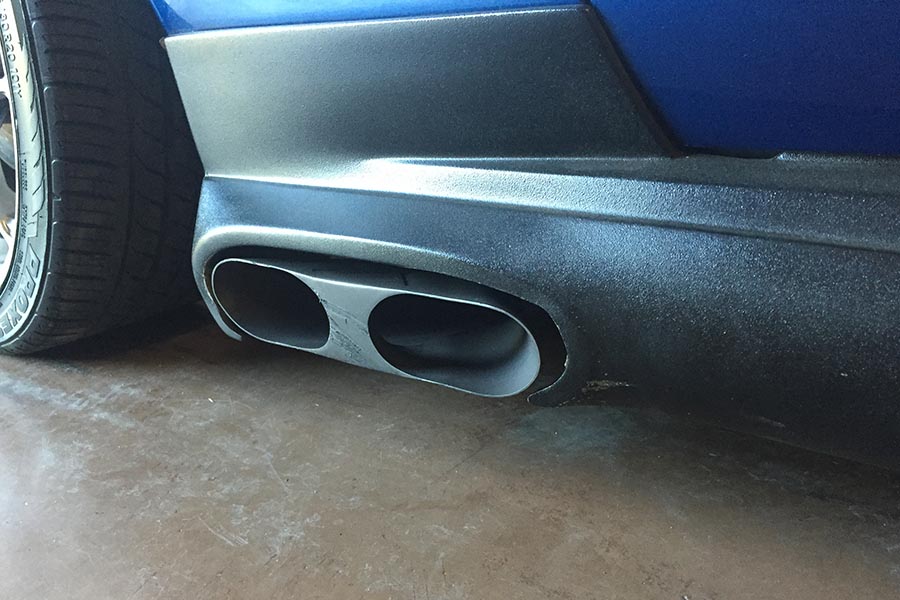
Your car’s exhaust emissions system is the only means of channelling away noxious gases such as carbon monoxide that are generated by your engine. If your exhaust system fails, fumes can potentially enter the vehicle cabin and prolonged exposure can be damaging to your health. Under existing regulations the Police have the power to remove any vehicle from the roads if they suspect it is producing excessive amounts of pollutant gases from the exhaust.
Look and listen: How to spot an exhaust problem
Many exhaust problems can be identified with a visual check. You should closely inspect the entire length of the exhaust from the engine all the way down to the tailpipe and look for any obvious cracks or holes, especially in places where one section meets the next e.g. the seams and joins between the exhaust manifold and the cylinder. External rust may not be as serious as it first appears, because it may only be on the surface. However if the component has rusted through or is rusted from the inside (due to the internal build up of condensation) it may be a cause for concern. Use a screwdriver to gently prod rusty areas; if the structural integrity feels weak, it could be a sign that the exhaust needs to be replaced, or at least part of it.
It might be useful to know that vehicles used for short trips around town tend to suffer from eroded exhausts in a much shorter time than those used for longer journeys. This is because the exhaust system doesn’t reach the temperature required to burn off accumulated water on these shorter trips.
Noisy exhausts often mean damaged exhausts. Listen out for unusual sounds coming from your exhaust system; strange sounds are a reliable way of detecting a problem.
The part of the exhaust known as the ‘silencer’ usually needs attention first, as it most likely to become corroded by the build up of acidic moisture. If you have a problem with your silencer you will know about it as your exhaust will begin to make a loud roaring noise, proving how effective a working silencer is at minimising noise from the exhaust system. Other noises to listen out for include hissing, which indicates a crack in the exhaust pipe or a leaking gasket, and a chugging noise could mean a blockage in the exhaust system.
A rattling sound from under the car is usually an indicator that the exhaust system has become misaligned, while a loud metallic vibration usually means that something is touching the exhaust pipe or that a clamp, support bracket or mounting is loose. Hangers and brackets hold your exhaust in place. Corroded, fractured or missing brackets and hangars can cause extra stress on the system which can also lead to avoidable failure.
Could your exhaust even be the problem?
If your exhaust begins to bellow smoke, this is more often than not an engine problem as opposed to the exhaust. Black exhaust smoke means that your engine is burning fuel too quickly so if this occurs, check your air filter, fuel injectors and the fuel pressure regulator. Alternatively, if you see white smoke coming from the exhaust, it may be nothing to worry about; it could simply be a build up of condensation in the exhaust system. However, if the exhaust continues to emit white smoke for an extended period of time, this suggests your engine is burning coolant and you may have a problem with your cylinder head or have a cracked head gasket. If coolant is leaking into your engine oil it will appeared discoloured and creamy.
The benefits of a healthy exhaust:
- optimum fuel efficiency
- improved engine performance
- noise control and quieter running
It is important to ensure your exhaust is working to the best of its ability and identifying a problem is fairly easy – just look and listen.
Faulty exhausts put your car at higher risk of failing its MOT, or worse still, putting your own health at risk. If you have any concerns regarding the health of your vehicles exhaust, head to Barrowford MOT today.
We’ll check your exhaust for cracks, leaks, breaks, wear and tear, corrosion, failed gaskets and pollutant gasses and will give guidance on any areas that do not meet the required standards. Call us on 01282 696351 and challenge us.


